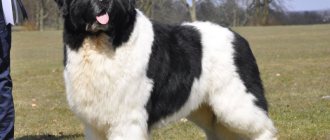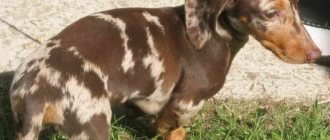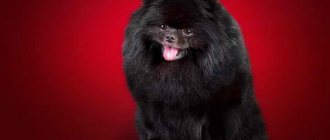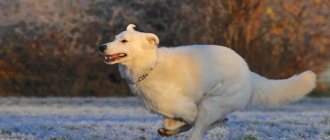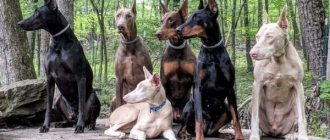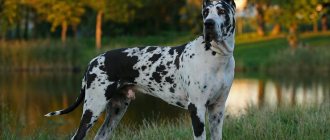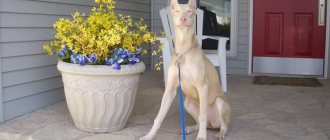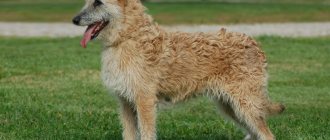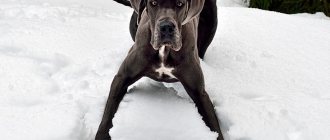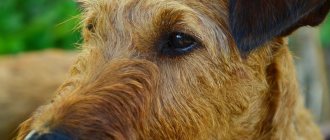The Irish Terrier was nicknamed the daredevil, and this nickname says a lot about his character. He is absolutely fearless, loyal to his masters and is a born vigilant and incorruptible protector. He may be a big fighter. Plus, he's always up for fun and is an overall wonderful family dog. The Irish Terrier bears close resemblance to its relatives, the Wire Fox Terrier and the Welsh Terrier. The main differences are as follows: the Irishman is characterized by a shiny red coat, a breed-specific body contour and medium size. And if you say that the Irish Terrier looks like a small Airedale Terrier with a solid golden-red color, this will not be to the taste of most lovers of this ancient and extremely attractive breed.
The coat should be thick and wiry in texture, dense, uneven, but nevertheless it should lie fairly close to the body. The hair grows so close to each other and fits so tightly that if you separate them from each other with your fingers, the skin is almost invisible. The coat should not be soft or silky. It should not be so long as to alter the contours of the body, especially on the back of the body and on the hind legs. The coat on the sides is never as coarse as on the back and legs, but it should be abundant and of the correct texture. At the base of the coarse hairs of the outer coat, thinner, softer hairs, lighter in color, called the undercoat, should grow. Single coats without any undercoat or wavy coats are not desirable. Curly and finely curled coats are highly undesirable.
Like the Airedale, the Irishman's coat needs to be plucked with your fingers several times a year. You can limit yourself to a haircut if the dog is no longer young, because... this leads to a “faded” color and loss of coat texture.
Procedure for grooming/cutting, trimming an Irish Terrier, preparing for an exhibition
Preparing an Irish Terrier for the show ring is not a difficult task, but only if you have a clear understanding of the principles of terrier trimming and the basic qualities of the coat of dogs of this breed.
The main principle is that it is necessary to do either stripping (pinching with a special knife) or plucking the wool by hand. If you closely examine a few hairs of an Irish Terrier's fur, then it will not be difficult to understand why this is necessary. Closer to the ends, red hair acquires a darker shade and becomes coarser, and as it approaches the skin, on the contrary, it becomes thinner and lighter. If the hair is cut, both the desired rich red color and the rough texture of the coat will be lost.
Basically, stripping involves pulling out long, dead hair, thereby making room for the growth of new hair, red and coarse. The stripping technique is as follows: you need to grab a small bunch of hair with your hand, holding it between your thumb and forefinger or between your thumb and the blunt blade of a stripping knife, and then sharply pull the hair in the direction in which it lies, but only against the hair.
Method for preparing the Irish Terrier's coat for an exhibition
Much attention should also be paid to such details as the general expression of the “face,” paws and claws, decorative fur, teeth and ears. In addition, you also need to remove some stray hairs on the belly, on the inside of the hind legs and around the base of the tail.
To achieve the desired expression, great care must be taken when trimming the head. The hair on the head should be kept short, but on the muzzle longer decorative hair may be left to add extra volume to the front of the muzzle. The beard towards the front end of the jaw should be left long enough to make the head appear elongated. However, the head should not be so long that the overall appearance of the dog becomes unbalanced.
The fur on the cheeks and throat should be trimmed very short to give the head and neck a clean, neat appearance. Cheek hair grows very quickly and should not be allowed to grow out of control.
The decorative coat becomes lighter and softer if dead hair is not removed regularly. Daily brushing of the whiskers and leg hair with a comb is usually sufficient to keep them in good condition. The Irish Terrier's coat should be brushed daily to keep the coat clean and lubricated with the natural lubricants normally found in the dog's coat and skin. For this purpose, use a natural bristle brush or a bristle mitten. Always brush the coat in the direction the hair lies, never in the opposite direction. For very coarse coats, it is also recommended to apply baby lubricant to the brush or mitten before combing, but this can be done no later than two weeks before the upcoming exhibition.
Grooming and conditioning of the coat should be done daily; only this regimen can lead to good results.
Breed traits
Breed traits (on a 5-point scale)
| Irish Terrier | |||
| Activity | in the house | 3.3 | |
| on the street | 4 | ||
| Obedience | training | 2.7 | |
| strangers | 4 | ||
| Domination | in family | 2.3 | |
| over dogs | 3.3 | ||
| Defending your territory | from people | 1.7 | |
| from dogs | 3 | ||
| Sociability | in family | 4.3 | |
| with strangers | 3.3 | ||
| with dogs | 2 | ||
| Concentration | in family | 1.7 | |
| in front of strangers | 2.7 | ||
| with dogs | 2.3 | ||
| Aggressiveness | in family | 1.7 | |
| to strangers | 1.7 | ||
| to the dogs | 3 | ||
| to cats | 3.3 | ||
| Family behavior | calmness | 3.3 | |
| demand for affection | 3 | ||
| excitability | 3.7 | ||
| playfulness | 4 | ||
| excessive barking | 2.7 | ||
| behavioral breakdowns | 2.3 | ||
| Tolerance for children | up to 4 years | 4.3 | |
| over 4 years old | 4.7 | ||
| Institutional use | watchman | 4 | |
| bodyguard | 1.7 | ||
This breed is often compared to the following dog breeds: Airedale Terrier, Welsh Terrier, Miniature Schnauzer (Standard Schnauzer), Wirehaired Fox Terrier, Dachshund.
Photos of Irish Terriers:
Trimming (stripping) of dogs
Trimming (stripping)
is a grooming procedure in which the dog's fur is plucked. This manipulation is used for wire-haired breeds. Old hairs are removed, allowing new coarse hairs to grow in, creating a true breed-appropriate appearance. This is especially important for show dogs. It is recommended to trim at least once every 4-6 months, otherwise the dog becomes overgrown and unkempt. It is enough to pull a few hairs; if they remain in your hand, then it’s time to trim.
Grooming dogs of wire-haired breeds disrupts the structure of the hair and makes it soft. The fur may become tangled and tangles may form. Without the hard end of the hair, the coat changes color and becomes dull.
Unlike cutting the coat, after trimming the dog looks great, the coat acquires a natural stiffness. Hard wool gets dirty less, does not tangle, and also does not have an unpleasant odor.
Trimming is necessary not only from the aesthetic side. The dog's skin becomes healthier and less susceptible to infections and parasites.
Trimming does not hurt your dog if done correctly. The hair of a wire-haired dog is attached differently than that of a human or a smooth-haired dog, so the old hair is easily removed. Many dogs that are regularly trimmed even enjoy this procedure. But if you have been grooming your dog for a long time and then decide to start trimming, the hair is not so easy to remove. Restoring a rough coat can take a long time. It is better to accustom your dog to this procedure from puppyhood.
You can trim your dog manually or using a special trimming knife.
, essentially a comb with fine teeth. It is necessary to catch a small amount of hair with a knife, and then, holding it with your thumb, pull it in the direction of hair growth to remove it. The hair should not be cut in half, but removed from the root.
It is better not to carry out the procedure in the next few days after washing, otherwise the hairs will slip out. For better adhesion to the hair, you can use special powder.
This procedure usually takes several hours.
Dossier
Adult height: 46-49 cm. Weight: male 12-23 kg, female 11-22 kg. Characteristic color: completely red, or wheaten, reddish-wheaten or yellow-red. Coat length: medium. Life expectancy: 12-15 years. Advantages of the breed: good guard, easy to get along with cats. Difficulties of the breed: does not get along well with other dogs, excessive shyness. Average price: puppies 350-500 dollars, adults 600-750 dollars. Classification: small; hunting dog.
Irish Terrier Trimming Scheme
Trimming a small puppy is both a necessary and, at the same time, enjoyable task. Once baby's fur is ready to be shed (sometimes as early as 6 weeks), you can begin to pluck it with your fingers. You can do this by holding the puppy on your lap after he has had a lot of play and is tired. The baby is trimmed to remove baby hair and allow new hair to grow.
It is better to comb the puppy on a special table; as a rule, he does not object to this. At the same time, you should teach him to stand on the table. Since all dogs love attention, and puppies especially, your pet will soon begin to look forward to this procedure, and by the time he needs serious trimming, he will already have a hard coat and will be trained enough to stand on the table properly. PLEASE REMEMBER! Never walk away leaving your puppy alone on the table! He may slip off the table and, falling, strangle himself in the noose or seriously injure himself. If this does not happen, then the puppy may simply get scared, and after that he will never stand on the table properly, and it is impossible to prepare a terrier for a show if he is standing on the ground. Puppy fur can be of very different quality: “babies” are already quite hard at 6 weeks, while others are fluffy and soft even at 6 months. But usually by 4 months they become tough, but only if you took the trouble in advance and plucked out the baby fluff. Early trimming is as necessary for the growth of a good coat, as trimming the nails to maintain the correct shape of the paw. Typically the first place a puppy develops wiry hair is at the base of its tail; and later you will notice that throughout the dog’s life, the thickest and toughest hair is in this place. The hair at the transition point from the head to the neck becomes coarse very slowly, and this is all the more strange, since on the head itself the hair is really wiry. The sides, throat and chest are, perhaps, the last parts of the body where wool of the required quality appears. Having emphasized the importance of plucking baby hair, let's see how it's done. Take a stiff bristle brush and brush against the grain all over your body. After this, your baby will look like a soft fluffy toy. Using the tips of your thumb and forefinger, grab a few of the longest hairs by the ends and pull these hairs in the direction of the fur. If the wool is ready, it will be easy to pluck. Do not grab hairs at the roots, close to the skin. Always hold and stretch the skin in front of the area you are going to remove hair from. If you don't do this, the puppy will be in pain and will not allow you to trim him. Please remember! We always pluck the fur by moving our hands back (toward us), and press the skin, pulling it forward (away from us). If the puppy’s fur is ready for plucking, we trim his entire body: body, neck, head, shoulders, throat. But. Do not touch the hair on the paws, as well as the mustache and beard. These are special places and they need special care. When trimming, pluck only the long hair, leaving the short hair as a base for the future and two- or three-layer changing guard hair. When the remaining short hair grows and dies, it will also be removed, but even shorter hair will remain. This begins the process of creating a constantly changing guard coat, the presence of which is highly desirable for a show wire-haired terrier. In the meantime, at the initial stage, the puppy’s mustache, beard and hair on the legs can be trimmed with scissors. Trim the hair around the paws, near the claws, so that the puppy collects less dirt and the paw looks neater. You can slightly trim the hair on the inside of the hocks and on the elbows so that it does not stick out in different directions. It is better to leave the beard and mustache alone, but do not forget that the puppy's head should look rectangular and the muzzle should not be wider than the cheeks. Despite the fact that you need to handle hair on your puppy’s legs, mustache and beard very carefully, do not forget that these parts of the body must always be clean, free of tangles and matted hair.
This is interesting: English knitting for a scarf collar
How to choose a puppy
The main problem when choosing an Irish Terrier puppy is the shortage of registered kennels, so sometimes you almost have to stand in line to buy babies.
- Irish Terrier puppies are distributed at 2-2.5 months, but it is better to get acquainted with them earlier, for example at 4 weeks of age.
- Evaluate the bitch's reaction to your arrival. If the dog tries to gather the cubs into a pile and cover them with his body, this is normal. Obvious cowardice and aggression towards a stranger is an alarming signal.
- The exhibition potential of Irish Terrier puppies reveals itself approximately in the fifth month of life, so if you are planning to get a show-class animal, delay the purchase longer.
- When a stranger appears, puppies should not run away as fast as they can. This suggests that the animals are raised in isolation and do not have contact with anyone other than the owner of the nursery.
- The right Irish Terrier puppy is sociable and responsive to affection. He willingly goes into his arms, exposes his belly for scratching, and allows himself to be touched.
Advantages and disadvantages
When treated well, dogs are docile and affectionate with their owners. They get along well with children. They are distinguished by cleanliness and activity. Good watchmen and rodent hunters. Very often they become favorites at various cynological exhibitions. They have stable health.
Most prone to the following diseases: melanoma, hip dysplasia, various allergies. Although friendly with people and cats, they do not get along well with dogs . They are also stubborn and assertive, but they are excellent companions on trips and walks.
Tell us about your Irish Terrier, its character, and your experience of caring for it. We look forward to your feedback and comments.
Feeding
An important issue in caring for a dog is nutrition. Here, for sure, what you put in is what you get. If you skimp on feeding your dog, you will end up with health problems for that very dog. And the money you save will be taken to the nearest veterinary hospital. And it’s not a fact that you won’t have to shell out much more money there than you spent on quality food
You can feed your Irish Terrier the same as any other dog.
If you decide to feed your pet dry food, then there is no problem; the only thing you need to do is pay attention to the quality of the food. Good food is labeled “premium” or “super-premium”
You should not buy other types of food; feeding such food can seriously harm your pet. Remember that if you decide to feed your dog dry food, the dog must have constant access to water at all times. The dog should always have water. The second option is feeding natural food.
If you decide to choose this feeding option, you should definitely consult with a specialist about what additives should be added to this food. The nutrients contained in regular food are not enough for the normal development of a dog. Well, it's time to draw conclusions.
So, the Irish Terrier is an excellent family dog. If you are looking for a loyal friend, companion and playmate, then the Irish Terrier is an excellent choice. If you are interested in this breed of dog, then find a photo of the Irish Terrier
you can on our website or anywhere else on the World Wide Web. Actually, that's all, come see us again.
Choosing a Groomer
- First, you need to decide where you will strip your pet. At home or in the salon. If you do it at home, you can save money, but there is also the possibility of an unqualified person coming in to do home haircuts for dogs. If you go to a salon, the cost of dog grooming will most likely be more expensive, but the specialist will almost certainly be experienced.
Before choosing a groomer, you need to look at his work. The best option would be if you can watch the hair removal process, and not just the finished work.
- Before going for a haircut, you can ask for advice and feedback from friends and acquaintances. Of course, this is not always a guarantee of good work. Groomers may not be generalists. For example, they may be good at grooming one breed of dog but not another. Listen carefully to all advice and draw your own conclusions.
- A good option is to get contact information from a good groomer from the breeder you bought your dog from. This option is the best, since most likely this master is really good at his job.
- When considering specialist options, analyze not only the quality of hair removal, but also the specialist’s manner of communication with dogs. Animals treat people differently; they feel how they treat themselves. Therefore, if your pet is happy with everything, it means that you have found your groomer.
What it is
Dogs are:
- short-haired;
- long-haired;
- Wire-haired.
For the first two types of wool, the usual care measures are sufficient - washing, drying, combing. With animals with hard hair, the situation is different.
You need to have the skills to work with a trimming knife for dogs and have an understanding of the distinctive features of the coat of various breeds. The process itself is similar to plucking. It is carried out by a master groomer. Using various tools, he removes the old fur to make room for the new.

